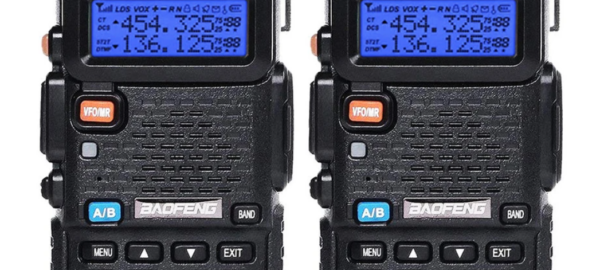The much maligned Baofeng UV5R is a good handi-talkie (HT) for new amateur radio operators to learn about operating techniques & channel programming and for find out who you want to talk to on local repeaters. When you know enough about what you really want to do with amateur radio to buy an advanced unit for 8-10x more, this will become your backup, hack-up or pay-it-forward radio.
Cons. In a word, the UV5R is cheap. It is built to be inexpensive and thus, while very usable and not fragile, it isn’t the best at receiving difficult signals or transmitting technically clean ones. And while not fragile, no one would call it rugged either. If you’re talking within the typical range for any given repeater, no one will think you sound bad and you’ll be able to hear the repeater just fine. However, if you’re near a source of interference like on a mountaintop with other repeaters, your receiver might be overwhelmed by nearby signals. Also, if someone gets out test gear, your radio will likely be shown to be transmitting very softly where it shouldn’t be doing so… on harmonics of your signal. While this is not likely to interfere with anyone else in a practical sense, it is not clean transmit.
Other cons include:
- Disreputable sellers. Stick with sellers with a reputation and a return policy, e.g. Radioddity, BTECH and Amazon among others. Part of the bad rep for this radio comes from sellers hawking cheaper knockoffs of this cheap radio or scammers who dress it up and sell it for way more.
- Bad bundled programming cables. The real cable is $20 standalone; if your kit includes software and driver CD, be aware you’ll likely need to add a better cable – these proprietary cables and drivers can be cranky at best and mess up your computer at worst. The cable that works and needs no 3rd party drivers will say it has a FTDI chip. If you don’t see that when buying a standalone cable, walk away.
- Difficult to program without computer. There are good 14 step guides to programming a repeater channel from the radio buttons. Careful, patient plodding will get it done. You’ll make mistakes, likely, and starting over on a channel is a pain. Other operations are just unavailable from the front panel.
- Not the latest display. Readable in sunlight, for sure, but very basic and like the older generations of radios, limited to 7 characters for channel names.
Pros. In a word, the UV5R is inexpensive. As of Spring 2021 you can still get a kit of 2 with batteries, chargers, antennas and earpieces for under $50. You’ll want the $20 FTDI programming cable and the capable community-supported open-source CHIRP software for your Windows or MacOS computer to program the radio. You don’t need anything else but the knowledge you can get from YouTube and repeaterbook.com to get started with local repeaters or simplex (radio-to-radio) communications.
Other pros include:
- Accessories are inexpensive. Some you might want later are battery eliminators, spare batteries, microphones and antennas. If you buy them from reputable sellers with a return policy, they will work and be the genuine article.
- Specialized accessories are plentiful, for example a cord that turns your pair of UV5R into a repeater or a cord that allows you to attach a terminal node controller or audio modem.
- You won’t cry if you break it as much as you would if you dropped your $200 radio.
- Five watts is 5W. In the vast majority of situations your UV5R is going to hear and be heard as well as any other radio in the 5W class. This goes especially for repeater communications where the other station (the repeater) is providing a good receive setup and powerful transmit. My first non-family contact was to a repeater 47 miles away with a UV5R and Nagoya 771 antenna – solid.
- Get your first mobile/base radio sooner. Make your first $200 radio a mobile rig to use in your car or home. You can get some great 2m or 70cm rigs under $200. There are even some dual band radios with great reputations under $200. That will give you 45-80 watts and open your horizon far more than a $200-500 handi-talkie upgrade from your UV5R. With your cheap HT for walking around and your mobile/base for more power, you’ll have much more fun and flexibility.
- The batteries seem to hold their charge better than even some more expensive radios. Off is off, it seems. Our UV5Rs are going in our “get home” bags. Just calendar a reminder to check operation/charge as often as you’re checking your perishables.
- If you like experimenting, having a $25 UHF/VHF transceiver is handy. There are several specialty kits/plans that incorporate one of these.
Final word. Get this radio or another under $100 (including all accessories) radio for your first HT. You don’t know what you don’t know when you’re starting out. Your experienced colleagues don’t know what kind of operating needs you will develop once you’re six months in. Spending $200 or more when you’re in this position could lead to regret.
If I was starting over and willing to spend what I did for 2+cable getting just one Baofeng + cable, I would get the UV5x3. In addition to having three bands, it has improved front panel programmability (you’ll want the FTDI cable still to program in bulk) and a display that can show you either 2 channels or 1 channel with both frequency and channel name. To me that is much more valuable than the BF-F8HP’s 8 watts (like 1Db xmit gain?).
My #1 accessory for this radio is a longer antenna: Nagoya 771, Signal Stick or Ed Fong Roll-up J-Pole get you more range and reception.
